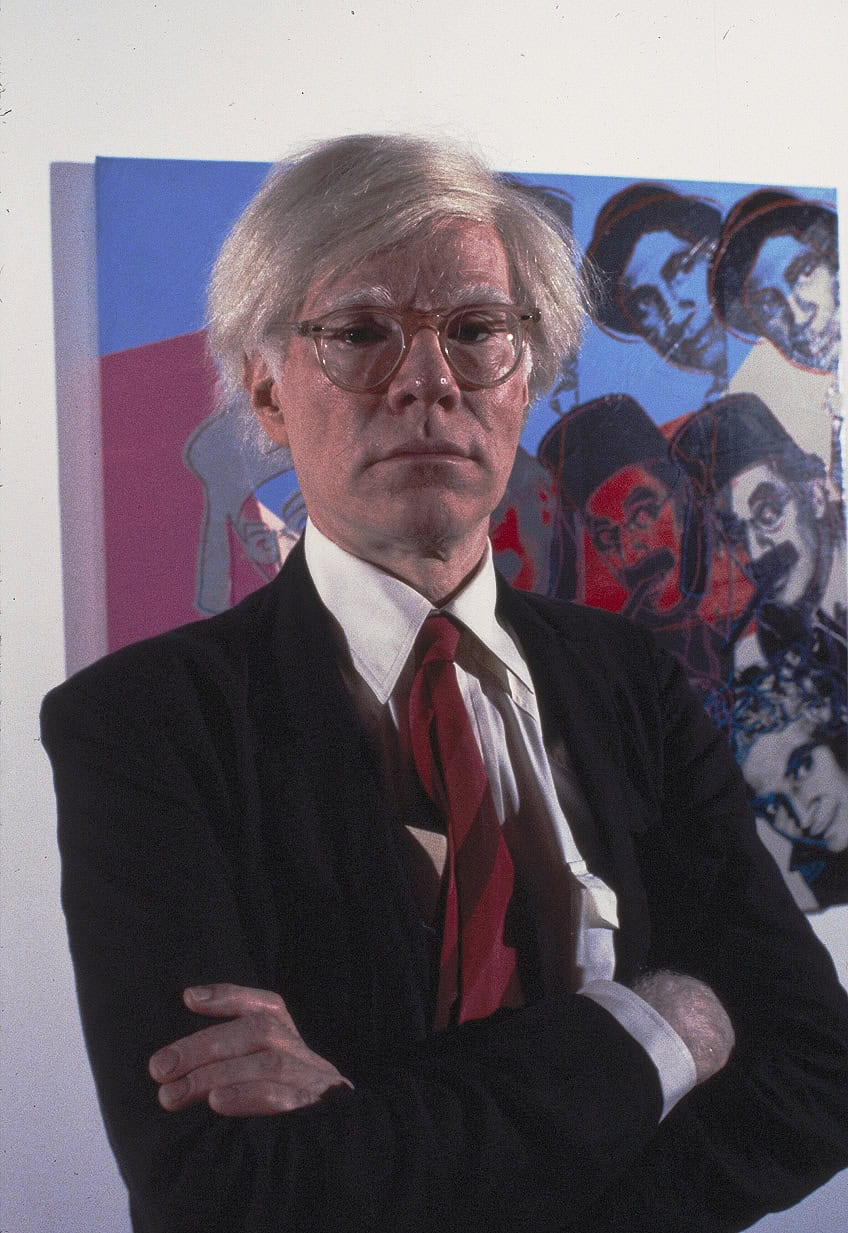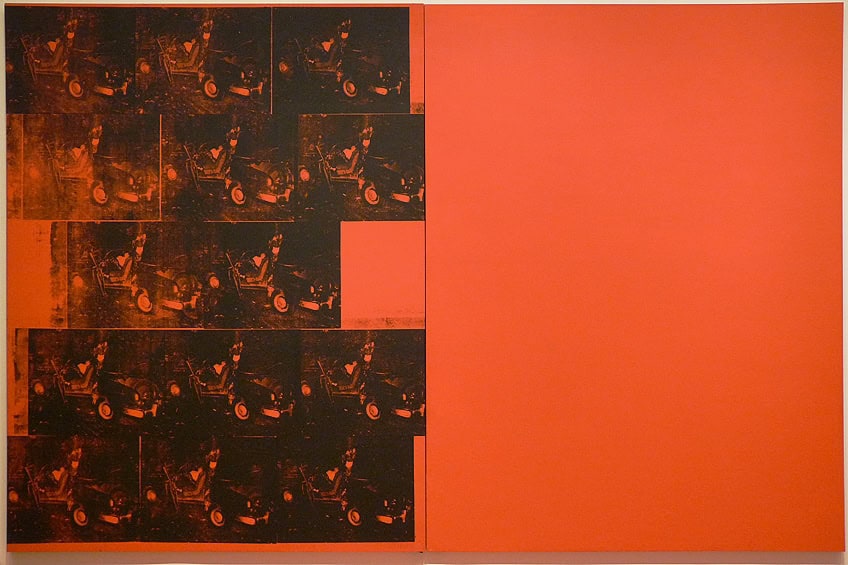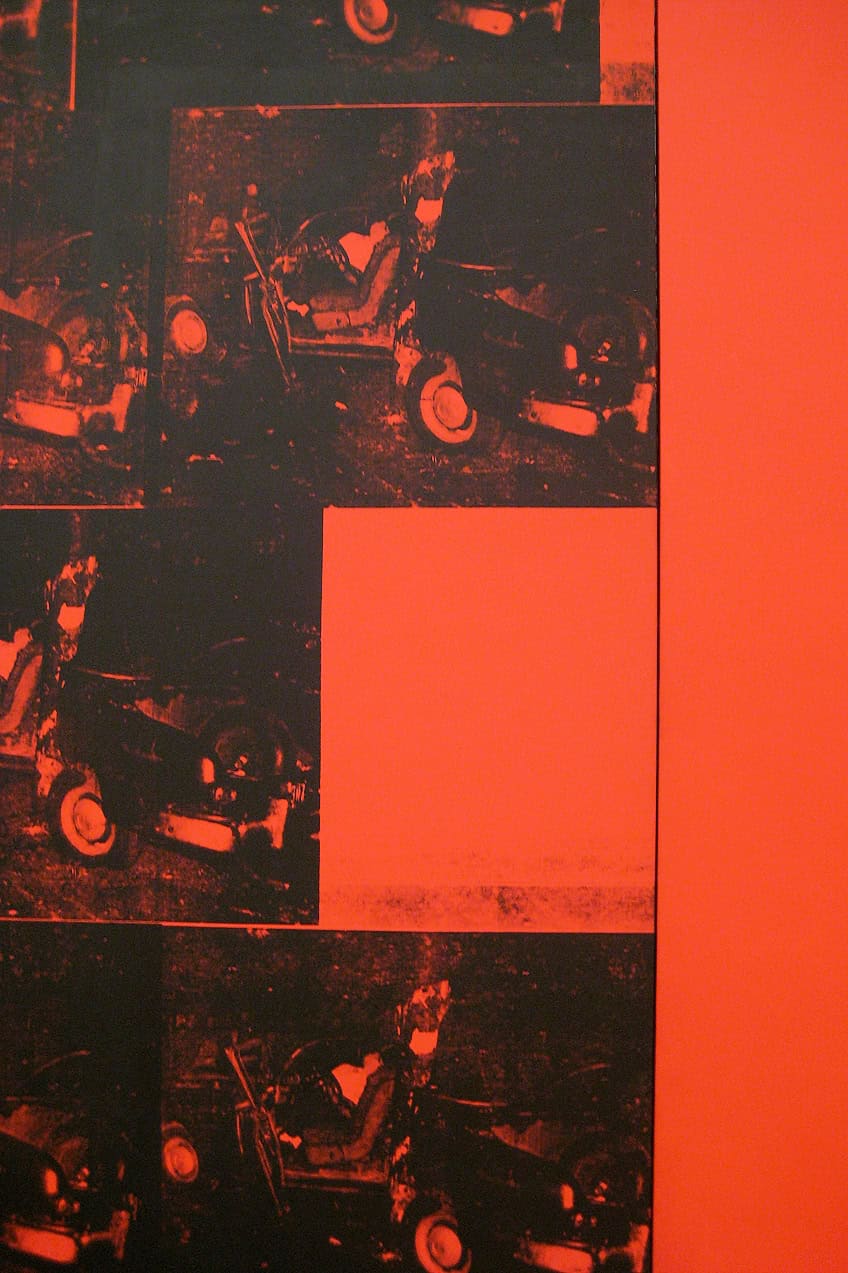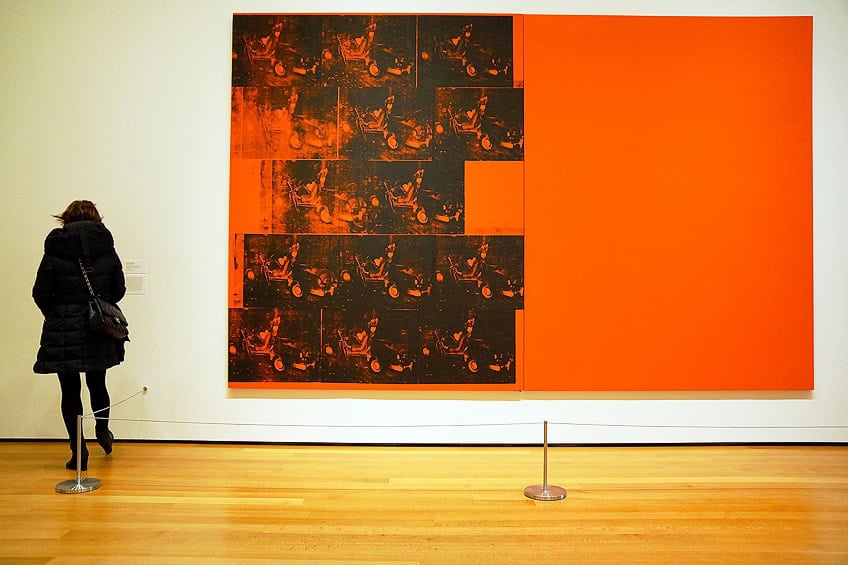“Orange Car Crash Fourteen Times” by Andy Warhol – Bold Art
Orange Car Crash Fourteen Times is an iconic artwork created by Andy Warhol in 1963 as part of his Death and Disaster series. This piece, characterized by its repetitive silkscreen technique and vivid orange hues, starkly contrasts the mundane with the macabre by depicting the aftermath of a fatal car accident. Warhol’s use of mass media imagery to confront themes of mortality and violence reflects his fascination with the commodification of tragedy in contemporary culture. By presenting the same haunting image fourteen times, Warhol not only desensitizes the viewer but also critiques society’s voyeuristic obsession with disaster and death.
Key Takeaways
- Orange Car Crash Fourteen Times captures a repeated image of a fatal car accident.
- The artwork is a part of Warhol’s Death and Disaster series.
- It is displayed at the Museum of Modern Art in New York City.
Historical Context and Warhol’s Vision
| Artist | Andy Warhol (1928 – 1987) |
|---|---|
| Date Created | 1963 |
| Medium | Silkscreen ink on acrylic on two canvases |
| Genre | Pop Art |
| Period/Movement | Pop Art |
| Dimensions (cm) | 268.9 × 416.9 |
| Series/Versions | Death and Disaster series |
| Where Is It Housed? | Various private collections and museums |
| What It Is Worth | Estimated in the tens of millions; significant cultural and historical value |
Andy Warhol, an iconic figure in the world of modern art, is well-known for his unique approach to highlighting everyday objects and sensational news stories. One of his most intriguing works, Orange Car Crash Fourteen Times, created in 1963, uses silkscreen ink and synthetic polymer paint on two large canvases. This artwork features the repeated image of a fatal car accident, capturing both the drama and desensitization of tragic news. Warhol’s technique of silkscreening allowed him to reproduce images with precision and to highlight the repetitive nature of media coverage.

Orange Car Crash Fourteen Times is part of his Death and Disaster series, which confronts the viewer with the relentless and often numbing presence of death in popular culture. Displayed at the Museum of Modern Art (MoMA) in New York, this piece stands as a testament to Warhol’s vision and his commentary on contemporary society. The stark contrast and repeated imagery force viewers to reflect on their own reactions to news and tragedy, making it a significant and enduring work in his collection.
Pop Art Movement and Warhol’s Influence
The Pop Art Movement emerged in the late 1950s and gained momentum in the 1960s. It involved artists using imagery from popular culture. Warhol, born in 1929, was a leading figure in this movement. His works often featured everyday objects and themes from mass media.
Warhol’s influence was profound. He created art using repetition and silkscreen techniques, making him stand out.
This method is evident in Orange Car Crash Fourteen Times, where he repeated a photo of a car accident. The use of bold colors and repetitive images brought attention to ordinary, yet startling, moments in American life. This repetition also emphasized the mechanization of modern society, portraying how violence and tragedy were becoming routine.
The 1960s: A Decade of Change and Controversy
The 1960s was a decade marked by significant social and political upheaval in the United States. 1963 was particularly notable for its events and tensions. During this time, movements for civil rights, women’s rights, and anti-war protests shaped the national conversation. Warhol’s art often mirrored these societal shifts. Orange Car Crash Fourteen Times was created amidst these changes. The shocking imagery of the car crash resonated with a period filled with public demonstrations and media coverage of violent events.

Warhol’s choice to depict such an event repeatedly highlighted the relentless exposure to graphic content in the media. This piece was a commentary on how such scenes were becoming commonplace and desensitized the public. Through his work, Warhol captured the essence of the era’s energy and uncertainty, reflecting the concerns and realities faced by contemporary American society in a clear and poignant manner.
Artwork Analysis
Orange Car Crash Fourteen Times by Andy Warhol is a striking piece from his Death and Disaster series, employing silkscreen techniques and synthetic polymer paint. This artwork is known for its use of repetition and its impactful, though somber, subject matter.
Technique and Composition
Warhol used silkscreen ink on synthetic polymer paint to create this artwork. The canvas was divided into two large panels, measuring about 268.9 x 416.9 cm in total. Repetition plays a crucial role here. Warhol replicated a single car crash image fourteen times. This repetitive approach gives the piece a hypnotic quality, drawing viewers into the tragic event repeatedly. He began by manually reproducing images but later preferred the efficiency of the silkscreen process. This method allowed Warhol to focus more on selecting impactful images rather than on the labor of creation.

Use of the Color Orange
The color orange in this work helps highlight the tragic scene. Orange, typically a vibrant and warm color, contrasts sharply with the morbid subject matter. The background color and the orange overlays intensify the shock value. Warhol’s choice of orange can be seen as a way to draw attention to the violence and chaos of the accident.
This usage of orange forces the viewer to confront the juxtaposition between life’s vibrancy and sudden death, thereby emphasizing the painting’s theme.
Cultural Impact and Critical Reception
Orange Car Crash Fourteen Times had a significant impact on art and culture. Part of Warhol’s Death and Disaster series, it sparked conversations about the portrayal of tragedy in media. Critics have both praised and lambasted the work. Some view the repeated images as a critique of society’s desensitization to violence due to constant media exposure. Others see it as an exploitation of tragedy for artistic gain. The piece remains relevant, serving as a powerful reflection on how repetitive exposure to disaster changes our perception of reality. Its critical reception continues to evolve as new interpretations and discussions emerge.
Orange Car Crash Fourteen Times in the Context of Museum Collections
Orange Car Crash Fourteen Times by Andy Warhol is integral to the modern art landscape, especially in how it is represented and preserved in museum collections. This section explores its acquisition, exhibit history, and conservation efforts.
Acquisition by The Museum of Modern Art
Andy Warhol’s Orange Car Crash Fourteen Times was acquired by The Museum of Modern Art (MoMA) in New York. It became part of their permanent collection, solidifying its status in contemporary art. Philip Johnson, a notable architect, played a pivotal role in championing Warhol’s works at MoMA.

The painting, created in 1963, includes silkscreen ink on synthetic polymer paint and consists of two canvases. Its addition to MoMA’s collection highlighted the importance of pop art in the museum’s archives. The artwork’s presence at MoMA helps contextualize the evolution of Warhol’s influence and the significance of his commentary on mass media and disaster.
Exhibit History and Ownership
Orange Car Crash Fourteen Times has been exhibited in multiple notable events since its acquisition. It debuted in MoMA’s exhibitions, drawing significant public and critical attention. The artwork has traveled to various international museums as part of retrospective Warhol exhibitions.
Exploring the exhibit history reveals shifting ownership and a deepening public interest in Warhol’s exploration of tragedy through repetition.
MoMA has frequently showcased this piece in themed exhibits like Automania, which explored the influence of automobiles on culture and art. Each exhibit has offered fresh insights into Warhol’s work, maintaining its relevance through decades.
Conservation and Preservation
Preserving Orange Car Crash Fourteen Times presents unique challenges due to its materials and large size. Conservation efforts at MoMA focus on preventing deterioration and maintaining the work’s vibrant colors and structural integrity.
Conservators examine factors such as light exposure, humidity, and environmental conditions. Recent advancements in art preservation techniques have enhanced efforts to prolong the life of Warhol’s iconic piece. By employing these methods, MoMA ensures that future generations can experience this seminal work as Warhol created it. Through meticulous attention, the museum continues to uphold its commitment to art conservation.
Orange Car Crash Fourteen Times stands as a compelling testament to Andy Warhol’s ability to intertwine art and societal commentary. By repeating the stark image of a car crash, Warhol challenges viewers to confront the pervasive nature of violence and the desensitization fostered by mass media. The artwork’s vibrant yet unsettling composition underscores the paradox of beauty and horror, emphasizing Warhol’s critique of a culture that consumes tragedy as easily as it does commercial products. This piece remains a powerful reflection on the human condition, solidifying Warhol’s legacy as a provocateur who masterfully blurred the lines between art, media, and reality.
Frequently Asked Questions
What Is the Significance of Andy Warhol’s Orange Car Crash Fourteen Times in the Context of His Art?
Andy Warhol’s Orange Car Crash Fourteen Times is part of his Death and Disaster series. He used this piece to highlight how media desensitizes people to tragedy by repeating distressing images.
What Cultural or Societal Commentary Was Andy Warhol Making With Orange Car Crash Fourteen Times?
Warhol’s piece comments on the media’s role in shaping public perception. By reproducing a car crash image repeatedly, he showed how these images lose their emotional impact over time.
What Has Been the Reception and Impact of Orange Car Crash Fourteen Times in the Art World?
Orange Car Crash Fourteen Times is considered a critical work within Warhol’s portfolio. It has been displayed in major museums, like the Museum of Modern Art (MoMA), indicating its lasting influence.
How Do Critics and Art Historians Interpret the Repetition of Imagery in Orange Car Crash Fourteen Times?
Critics suggest the repeated imagery reflects Warhol’s fascination with mass production and media saturation. The repetition emphasizes the numbness that can result from constant exposure to tragic events.
Jordan Anthony is a Cape Town-based film photographer, curator, and arts writer. She holds a Bachelor of Art in Fine Arts from the University of the Witwatersrand, Johannesburg, where she explored themes like healing, identity, dreams, and intuitive creation in her Contemporary art practice. Jordan has collaborated with various local art institutions, including the KZNSA Gallery in Durban, the Turbine Art Fair, and the Wits Art Museum. Her photography focuses on abstract color manipulations, portraiture, candid shots, and urban landscapes. She’s intrigued by philosophy, memory, and esotericism, drawing inspiration from Surrealism, Fluxus, and ancient civilizations, as well as childhood influences and found objects. Jordan is working for artfilemagazine since 2022 and writes blog posts about art history and photography.
Learn more about Jordan Anthony and about us.
Cite this Article
Jordan, Anthony, ““Orange Car Crash Fourteen Times” by Andy Warhol – Bold Art.” artfilemagazine – Your Online Art Source. June 28, 2024. URL: https://artfilemagazine.com/orange-car-crash-fourteen-times-by-andy-warhol/
Anthony, J. (2024, 28 June). “Orange Car Crash Fourteen Times” by Andy Warhol – Bold Art. artfilemagazine – Your Online Art Source. https://artfilemagazine.com/orange-car-crash-fourteen-times-by-andy-warhol/
Anthony, Jordan. ““Orange Car Crash Fourteen Times” by Andy Warhol – Bold Art.” artfilemagazine – Your Online Art Source, June 28, 2024. https://artfilemagazine.com/orange-car-crash-fourteen-times-by-andy-warhol/.



